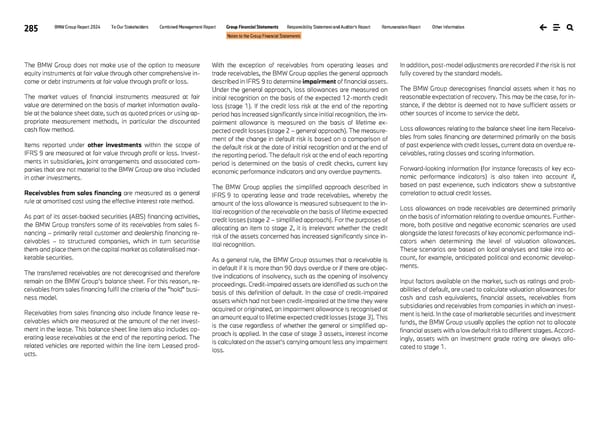285 BMW Group Report 2024 To Our Stakeholders Combined Management Report Group Financial Statements Responsibility Statement and Auditor’s Report Remuneration Report Other Information Notes to the Group Financial Statements The BMW Group does not make use of the option to measure equity instruments at fair value through other comprehensive in- come or debt instruments at fair value through profit or loss. The market values of financial instruments measured at fair value are determined on the basis of market information availa- ble at the balance sheet date, such as quoted prices or using ap- propriate measurement methods, in particular the discounted cash flow method. Items reported under other investments within the scope of IFRS 9 are measured at fair value through profit or loss. Invest- ments in subsidiaries, joint arrangements and associated com- panies that are not material to the BMW Group are also included in other investments. Receivables from sales financing are measured as a general rule at amortised cost using the effective interest rate method. As part of its asset-backed securities (ABS) financing activities, the BMW Group transfers some of its receivables from sales fi- nancing – primarily retail customer and dealership financing re- ceivables – to structured companies, which in turn securitise them and place them on the capital market as collateralised mar- ketable securities. The transferred receivables are not derecognised and therefore remain on the BMW Group’s balance sheet. For this reason, re- ceivables from sales financing fulfil the criteria of the "hold" busi- ness model. Receivables from sales financing also include finance lease re- ceivables which are measured at the amount of the net invest- ment in the lease. This balance sheet line item also includes op- erating lease receivables at the end of the reporting period. The related vehicles are reported within the line item Leased prod- ucts. With the exception of receivables from operating leases and trade receivables, the BMW Group applies the general approach described in IFRS 9 to determine impairment of financial assets. Under the general approach, loss allowances are measured on initial recognition on the basis of the expected 12-month credit loss (stage 1). If the credit loss risk at the end of the reporting period has increased significantly since initial recognition, the im- pairment allowance is measured on the basis of lifetime ex- pected credit losses (stage 2 – general approach). The measure- ment of the change in default risk is based on a comparison of the default risk at the date of initial recognition and at the end of the reporting period. The default risk at the end of each reporting period is determined on the basis of credit checks, current key economic performance indicators and any overdue payments. The BMW Group applies the simplified approach described in IFRS 9 to operating lease and trade receivables, whereby the amount of the loss allowance is measured subsequent to the in- itial recognition of the receivable on the basis of lifetime expected credit losses (stage 2 – simplified approach). For the purposes of allocating an item to stage 2, it is irrelevant whether the credit risk of the assets concerned has increased significantly since in- itial recognition. As a general rule, the BMW Group assumes that a receivable is in default if it is more than 90 days overdue or if there are objec- tive indications of insolvency, such as the opening of insolvency proceedings. Credit-impaired assets are identified as such on the basis of this definition of default. In the case of credit-impaired assets which had not been credit-impaired at the time they were acquired or originated, an impairment allowance is recognised at an amount equal to lifetime expected credit losses (stage 3). This is the case regardless of whether the general or simplified ap- proach is applied. In the case of stage 3 assets, interest income is calculated on the asset’s carrying amount less any impairment loss. In addition, post-model adjustments are recorded if the risk is not fully covered by the standard models. The BMW Group derecognises financial assets when it has no reasonable expectation of recovery. This may be the case, for in- stance, if the debtor is deemed not to have sufficient assets or other sources of income to service the debt. Loss allowances relating to the balance sheet line item Receiva- bles from sales financing are determined primarily on the basis of past experience with credit losses, current data on overdue re- ceivables, rating classes and scoring information. Forward-looking information (for instance forecasts of key eco- nomic performance indicators) is also taken into account if, based on past experience, such indicators show a substantive correlation to actual credit losses. Loss allowances on trade receivables are determined primarily on the basis of information relating to overdue amounts. Further- more, both positive and negative economic scenarios are used alongside the latest forecasts of key economic performance indi- cators when determining the level of valuation allowances. These scenarios are based on local analyses and take into ac- count, for example, anticipated political and economic develop- ments. Input factors available on the market, such as ratings and prob- abilities of default, are used to calculate valuation allowances for cash and cash equivalents, financial assets, receivables from subsidiaries and receivables from companies in which an invest- ment is held. In the case of marketable securities and investment funds, the BMW Group usually applies the option not to allocate financial assets with a low default risk to different stages. Accord- ingly, assets with an investment grade rating are always allo- cated to stage 1.
 BMW Group Report 2024 Page 284 Page 286
BMW Group Report 2024 Page 284 Page 286